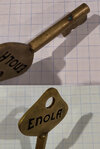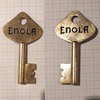brendonsmall
Active Member
Hi all,
I am in the final leg of my months long build of the "Enola" key from Crimson Peak. I started in January 2019 by gathering information through screen captures, general key research, sketches, and 3D modelling.
I've made 3 prototype PA12-grade 3D prints to ensure size and feel were correct, and have finally pulled the trigger on a lost wax casting in brass. The next steps will be weathering and aging. I plan to use some other keys/coins to add some scratches and dents, some light heat treatment, mild acid application, and some probably enamel fill for the lettering.
My goal is to complete my first ever "screen match" scratch built prop, and I could not be more enthusiastic about it
Will be posting more pictures and information here over the coming days and weeks
I am in the final leg of my months long build of the "Enola" key from Crimson Peak. I started in January 2019 by gathering information through screen captures, general key research, sketches, and 3D modelling.
I've made 3 prototype PA12-grade 3D prints to ensure size and feel were correct, and have finally pulled the trigger on a lost wax casting in brass. The next steps will be weathering and aging. I plan to use some other keys/coins to add some scratches and dents, some light heat treatment, mild acid application, and some probably enamel fill for the lettering.
My goal is to complete my first ever "screen match" scratch built prop, and I could not be more enthusiastic about it
Will be posting more pictures and information here over the coming days and weeks


